

Medieval Fashion. During the history of mankind, fashion was always a subject of controversy, and Medieval fashion followed the rule.
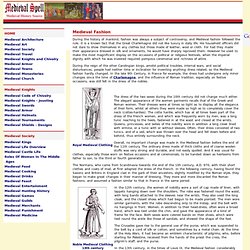
It is a known fact that the Great Charlemagne did not like luxury in daily life. His household officers did not dare to show themselves in any clothes but those made of leather, wool or cloth. For had they made their appearance dressed in silk and ornaments, he would have sharply reproved them. However he used to make the most magnificent display on the occasions of political or religious festivals, when the imperial dignity with which he was invested required pompous ceremonial and richness of attire. During the reign of the other Carolingian kings, amidst political troubles, internal wars, and social disturbances, people had neither time or inclination for inventing anything dress related, so the Medieval fashion hardly changed.
Royal Medieval Clothing The dress of the two sexes during the 10th century did not change much either. Noble Medieval Clothing13th century. Creating new religions. A WAY WITH WORLDS: CREATING NEW RELIGIONSBy Steven Savage Archives available at The Way With Worlds Home Page Well, we're back on the creativity track after a few diversions, and back on the subject of religion in your continuity.
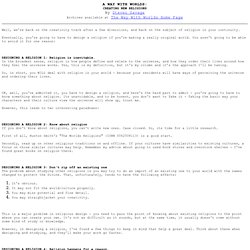
Eventually, you're going to have to design a religion if you're making a really original world. You aren't going to be able to avoid it for one reason: Hobbit Name Generator - Lord of the Rings. What did people do in a Medieval City? What did people do in the Middle Ages?
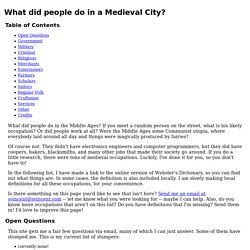
If you meet a random person on the street, what is his likely occupation? Or did people work at all? Were the Middle Ages some Communist utopia, where everybody laid around all day and things were magically produced by fairies? Of course not. They didn't have electronics engineers and computer programmers, but they did have coopers, bakers, blacksmiths, and many other jobs that made their society go around. In the following list, I have made a link to the online version of Webster's Dictionary, so you can find out what things are. Is there something on this page you'd like to see that isn't here? Open Questions This site gets me a fair few questions via email, many of which I can just answer.
Currently none! Medieval Price List. [Courtesy of Kenneth Hodges hodges@jif.berkeley.edu ] The list of medieval prices which follows is by no means complete or thoroughly researched; I merely extracted references from some of the books I have, and I thought others might like to inspect it. The sources I used are listed at the end. If an item is listed several times, it is because I had several references I wished to record. Money goes as follows: ARMA Reading & Research. Reading & Research List ARMA presents the Internet’s most extensive bibliographical listing of published reference works and suggested sources for Medieval and Renaissance fencing. (1/2002) "what can we do better than gather our books around us?
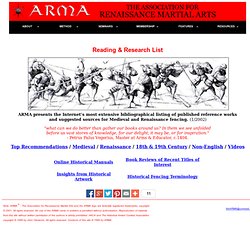
In them we see unfolded before us vast stores of knowledge, for our delight, it may be, or for inspiration. " - Petrus Palus Vegerius, Master at Arms & Educator, c.1404. Top Recommendations / Medieval / Renaissance / 18th & 19th Century / Non-English / Videos. iG's Calendar Maker. Word Tools. Wind Names. Fairy Names, Meaning's and Myths. Totro, the Fantasy Random Name Generator, Version 1.01. This is Totro, a random name generator for fantasy names (of characters, places, and so on).
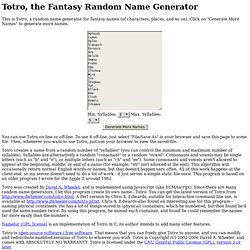
Click on "Generate More Names" to generate more names. You can use Totro on-line or off-line. To use it off-line, just select "File/Save As" in your browser and save this page to some file. Then, whenever you want to use Totro, just use your browser to view the saved file. Totro creates a name from a random number of "syllables" (you can control the minimum and maximum number of syllables).
Totro was created by David A. Namelur (GPL license) is an implementation of Totro in C; its author intends to add many other features. Totro is open source software / free software. On Thud and Blunder. Introduction. Update Information 2006: In 2006 the Internet Medieval Sourcebooks and associated sourcebooks are undergoing a major overhaul to remove bad links and add more documents. 2. This project is both very large and fairly old in Internet terms. At the time it was instigated (1996), it was not clear that web sites [and the documents made available there] would often turn out to be transient. As a result there is a process called "link rot" - which means that a "broken link" is a result of someone having taken down a web page. 2. 3.
Note: This site aims to present medieval sources. Sourcebook Contents The Internet Medieval Sourcebook is organized as three main index pages, with a number of supplementary documents. Selected Sources This is the main entry to the resources here. Full Text Sources Full texts of medieval sources arranged according to type. Saints' Lives Devoted to Ancient, Medieval and Byzantine hagiographical sources. Supplementary Documents Help! Internet Sourcebook: Multimedia. Love's Sacred Hert.